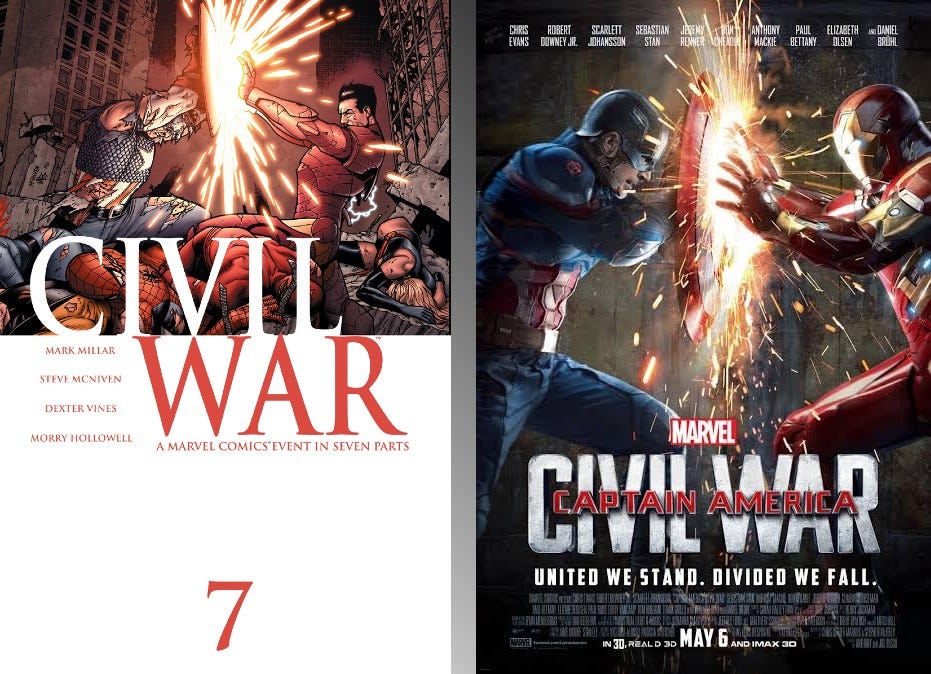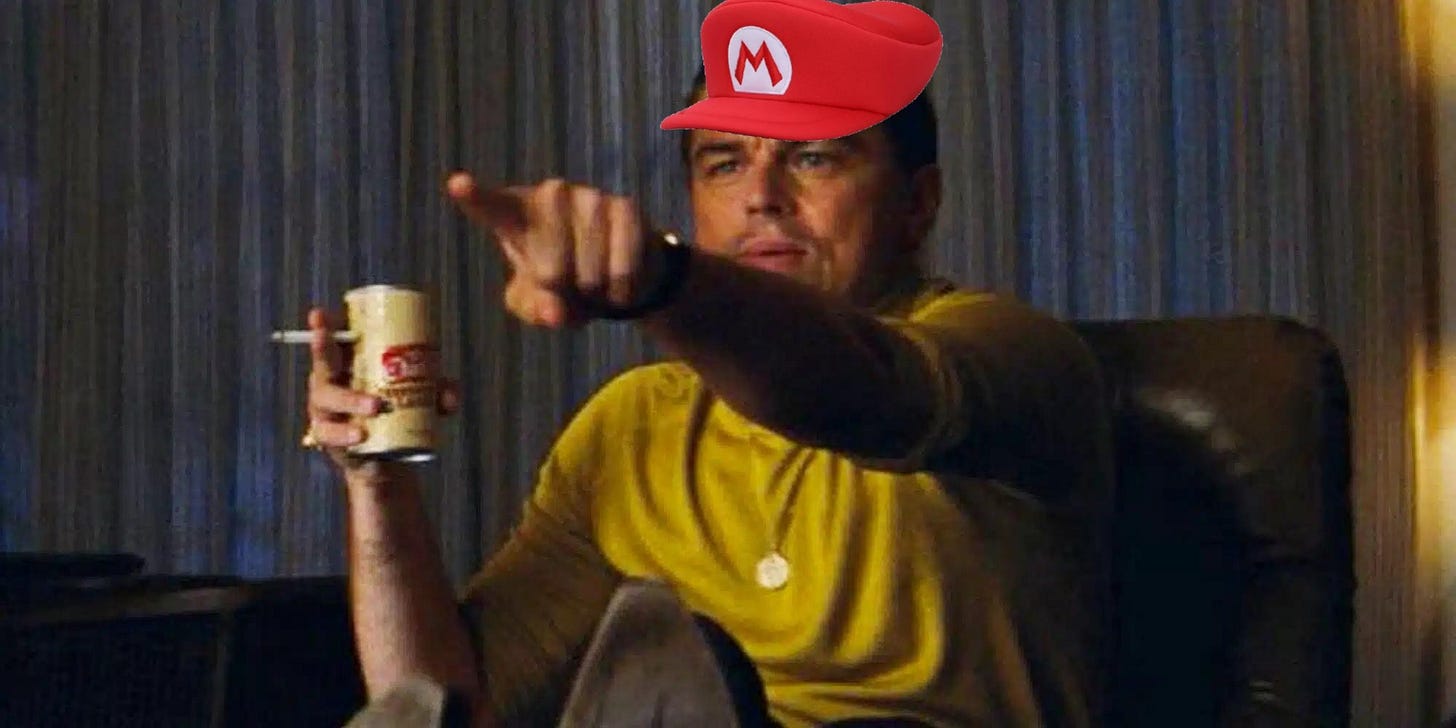The first major video-game-to-movie adaptation, Super Mario Bros., is known for being two things: a box office bomb, and completely bonkers.
At twelve years old, I wasn’t exactly a discerning filmgoer, and yet the movie still failed to meet my modest expectations. How did this happen?
Remediating Success
As I said in Part 1 of this piece, Mario doesn’t have much of a character, and his games (especially on the NES console) have very little story, so the filmmakers were required to make one up. It was absolutely nuts, but that likely could’ve been forgiven by the target audience (i.e. me and my friends).1
However, there were certain iconic elements of the Mario games, even in 1993, that kids were expecting to see. The audience still demanded—as explained in Part 2—stylistic remediation (without actually using the pretentious film school terminology, of course).
Instead, we got this—
The makers of the The Super Mario Bros. Movie (2023) learned their lesson. The story still doesn’t make a ton of sense, but they managed to at least look like the game, and refer back to the beloved source material. The result was something like 35 times the box office.2
The makers of superhero movies discovered the advantage of stylistic remediation in the early 2000s, starting with Raimi’s Spider-Man. (Bryan Singer deliberately did not remediate comic book style, preferring a more “realistic” approach.)3
Rarely is a comic story directly adapted to the screen, though. Just to take one example, the MCU’s Civil War is more of a skirmish compared with its comic book counterpart. Yet, the iconic cover of the climactic issue is stylistically remediated into the film, and subsequently repurposed in the marketing.
Part of the reason comic book stories can’t be adapted to films is that they’re merely a segment of a decades-long, interconnected narrative. Rarely have the same characters and narrative threads lined up so that a one-to-one adaptation is even possible. But even taken in isolation, comic book stories tend to be long.
Which is also a challenge when adapting video games.
It’s Playtime
Modern narrative games are expected to last twenty, thirty, even sixty hours. It’s like trying to adapt a Tolstoy novel.
Of course, much of a game’s playtime is in, well, playing. Essentially, extended action and suspense sequences that last far longer than they could in any movie. But even removing those, a plain adaptation of a modern game would require too much screentime. That’s why Hollywood often produces either full television series, like The Last of Us, or prequel films with original stories, like Uncharted.
Until Dawn (the game) is about 8-10 hours, which isn’t terribly long for a AAA title, but it is about six slasher movie’s worth of runtime. The story could possibly be condensed, with some side plots removed (as well as maybe a character or two). The problem is that the game already stylistically re-mediates horror movies ranging from Psycho and The Shinning to Scream and The Descent. Bringing that all back into a movie would be a snake eating its own tail composed of tropes and clichés.
The more interesting conundrum for the filmmakers was how to handle the Choose Your Own Adventure-style gameplay.
Gamification of Cinema
Until Dawn is unusual in that he doesn’t allow save scumming.4 The decisions you make are permanent and irreversible. You make a mistake that leads to a character’s death, they stay dead. Which is typical of narrative cinema, due to be a linear medium.
Having already decided to throw out the long plot and excessive number of characters, the makers of the Until Dawn film decided to also forgo stylistic remediation of the source material. In complete opposition to the original game, Until Dawn is a time loop movie. After all of the characters are killed, the story resets to the beginning. They’re aware that time is repeating (so more like Groundhog Day than the TNG episode “Cause and Effect”), and have a chance to correct their mistakes. You know, like most video games… except the one, specific game this movie is based on.
They added a gimmick that each loop pays homage to a specific subgenre of horror (slasher, body horror, found footage). It’s kind of a cross between Happy Death Day and Cabin in the Woods, without any of the good qualities implied by either.5
Until Mario
Don’t get me wrong, David F. Sandberg is a talented director—there are some scary scenes—but the movie didn’t seem to be about anything other than itself.
The recent Super Mario Bros movie may have been a cash-grab, but at least one gets the sense the filmmakers wanted the audience to have a collective nostalgic experience.
The making of the ‘93 original convinced the studio to give them money to make their own, original project, and slap an IP on it. You almost have to respect their hustle.
Until Dawn (the movie) is similar, except that it re-mediate game-like qualities (replaying the same section over and over) in the exact way that Until Dawn is un-gamelike. The whole process is rather baffling, appealing to neither fans of the game nor the broader horror audience.
In conclusion, the game is somehow more cinematic than the movie, while the movie is more gamified than the game, and I’ve probably now spent more time thinking about this than the writers did.
It’s possible they “didn’t understand the assignment,” as the kids say these days, and they just decided to do whatever they wanted and slap the Mario name on it. Like the old joke about Starship Troopers, critics understood the movie about as well as Paul Verhoeven understood the book. Then again, I don’t want to go digging around for some secret, hidden meaning in Super Mario Bros that we all missed in 1993.
Yes, inflation is a thing, but it’s difficult to compare movies made so far apart for other reasons, such as the shortened release window and the greater reliance on foreign revenues. The point remains—the new Super Mario Bros is a hit, whereas as the original was a flop.
See my video essay on genre cycles for more about the first generation of superhero movies.
Realizing you’ve made a mistake in gameplay, and reverting to an earlier save to play the same section again.
To be honest, while I know it’s now considered a beloved classic, I have some issue with Cabin. But that’s a post for another day.











